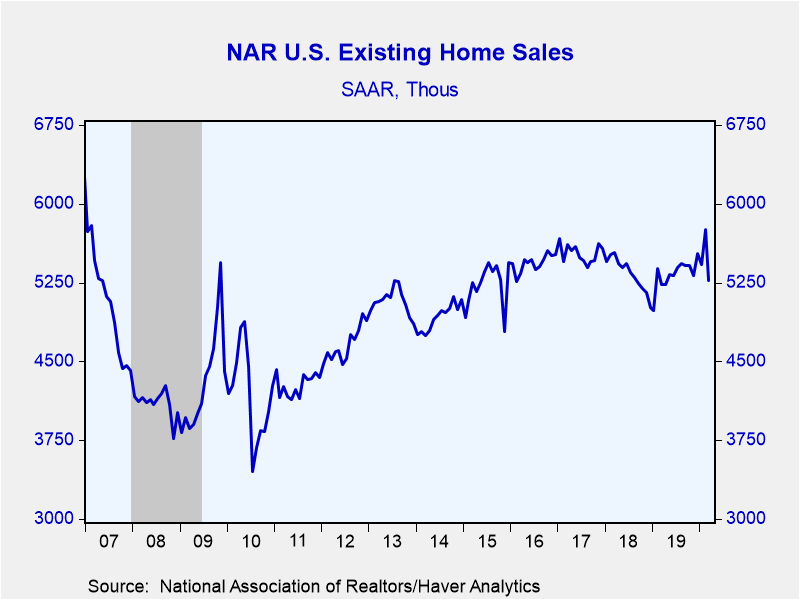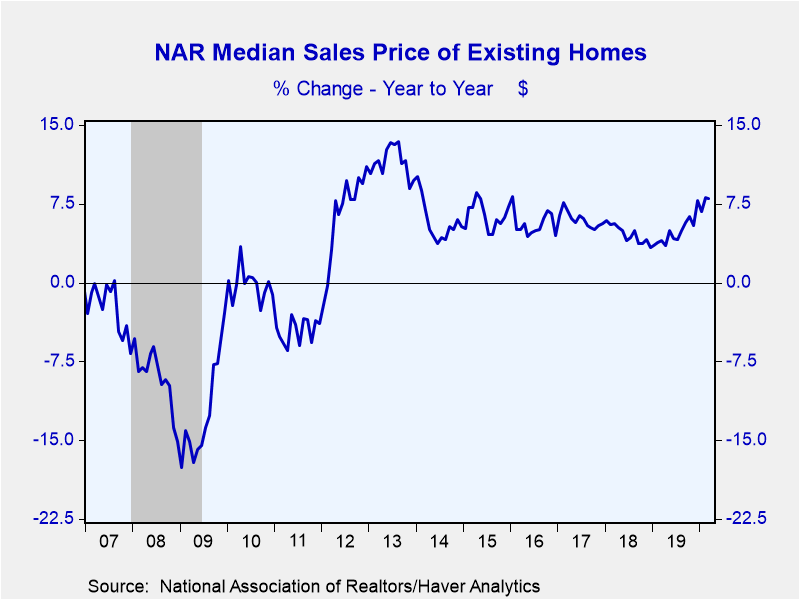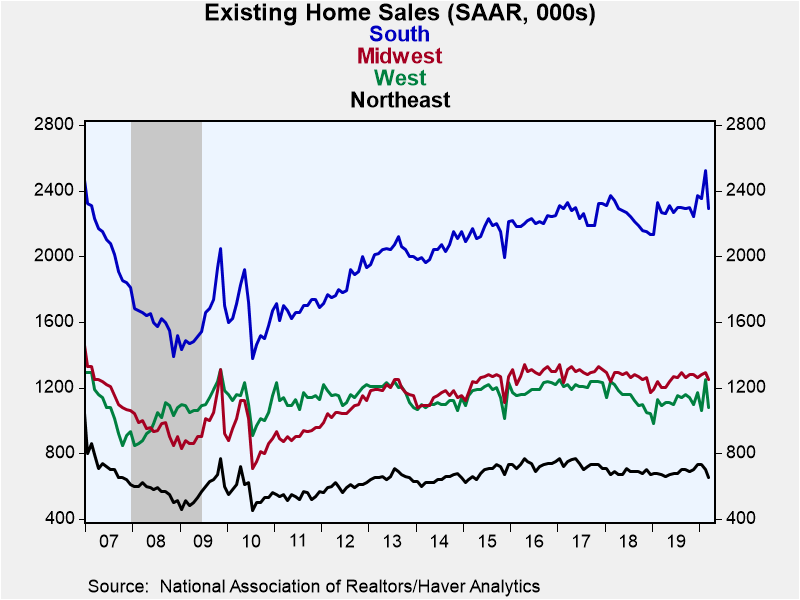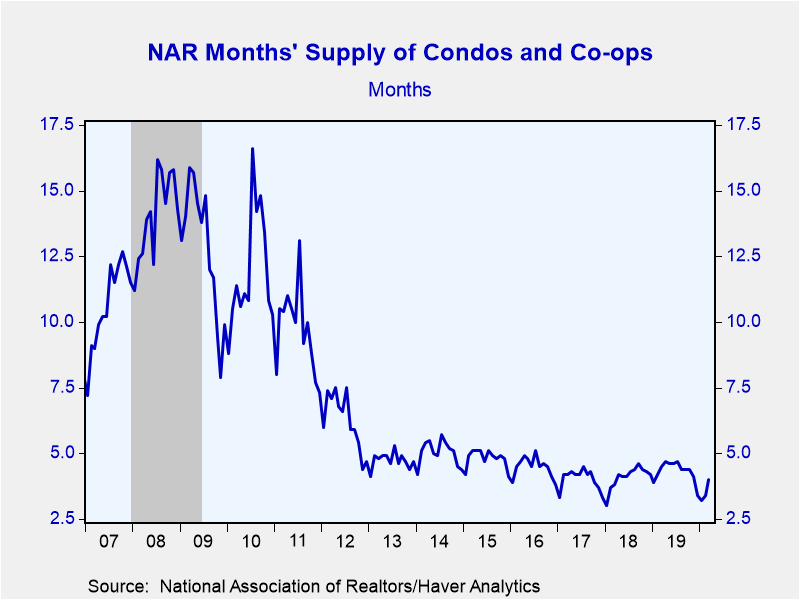 Global| Apr 21 2020
Global| Apr 21 2020U.S. Existing Home Sales Pull Back but Prices Rise
by:Tom Moeller
|in:Economy in Brief
Summary
• Existing home sales near 2019 low as coronavirus sets in. • Sales decline around the country. • Prices improved before quarantine. The National Association of Realtors (NAR) reported that sales of existing homes during March [...]
• Existing home sales near 2019 low as coronavirus sets in.
• Sales decline around the country.
• Prices improved before quarantine.
The National Association of Realtors (NAR) reported that sales of existing homes during March declined 8.5% (+0.8% y/y) to 5.270 million (AR) from 5.760 million in February, revised from 5.770 million. It was the lowest level of sales since April of last year. The Action Economics Forecast Survey expected March sales of 5.30 million.
The median price of all existing homes sold increased 3.8% (NSA, 8.0% y/y) to $280,600 following a 1.6% February increase. The average sales price improved 3.3% last month (6.2% y/y) to $316,000. These price data are not seasonally adjusted.
Existing home sales weakened around the country in March. In the West, sales fell 13.6% (-0.9% y/y) to 1.080 million and reversed the increase in February. Sales in the South declined 9.1% (+0.9% y/y) to 2.290 million, the lowest level since November. In the Northeast, sales fell 7.1% (-3.0% y/y) to 650,000, roughly five-year low. Sales in the Midwest were off 3.1% (+4.2% y/y) to 1.250 million, the lowest level since May of last year.
Sales of existing single-family homes weakened 8.1% (+1.3% y/y) to 4.740 million units and reversed February's rise. Sales of condos and co-ops plunged 11.7% (-3.6% y/y) to 530,000 units, the lowest level since July 2012.
The number of homes on the market decreased 10.2% y/y, but rose seasonally in recent months. The months' supply of homes on the market improved m/m to 3.4 but compared to 3.8 one year earlier. These inventory figures date back to 1999.
The data on existing home sales, prices and affordability are compiled by the National Association of Realtors and can be found in Haver's USECON database. The regional price, affordability and inventory data are available in the REALTOR database. The expectations figure is from the Action Economics Forecast Survey, reported in the AS1REPNA database.
| Existing Home Sales (SAAR, 000s) | Mar | Feb | Jan | Mar Y/Y % | 2019 | 2018 | 2017 |
|---|---|---|---|---|---|---|---|
| Total Sales | 5,270 | 5,760 | 5,420 | 0.8 | 5,330 | 5,341 | 5,531 |
| Northeast | 650 | 700 | 730 | -3.0 | 687 | 689 | 735 |
| Midwest | 1,250 | 1,290 | 1,280 | 4.2 | 1,248 | 1,265 | 1,301 |
| South | 2,290 | 2,520 | 2,350 | 0.9 | 2,281 | 2,246 | 2,270 |
| West | 1,080 | 1,250 | 1,060 | -0.9 | 1,115 | 1,141 | 1,225 |
| Single-Family Sales | 4,740 | 5,160 | 4,820 | 1.3 | 4,754 | 4,742 | 4,907 |
| Median Price Total ($, NSA) | 280,600 | 270,400 | 266,200 | 8.0 | 269,783 | 257,267 | 245,950 |
Tom Moeller
AuthorMore in Author Profile »Prior to joining Haver Analytics in 2000, Mr. Moeller worked as the Economist at Chancellor Capital Management from 1985 to 1999. There, he developed comprehensive economic forecasts and interpreted economic data for equity and fixed income portfolio managers. Also at Chancellor, Mr. Moeller worked as an equity analyst and was responsible for researching and rating companies in the economically sensitive automobile and housing industries for investment in Chancellor’s equity portfolio. Prior to joining Chancellor, Mr. Moeller was an Economist at Citibank from 1979 to 1984. He also analyzed pricing behavior in the metals industry for the Council on Wage and Price Stability in Washington, D.C. In 1999, Mr. Moeller received the award for most accurate forecast from the Forecasters' Club of New York. From 1990 to 1992 he was President of the New York Association for Business Economists. Mr. Moeller earned an M.B.A. in Finance from Fordham University, where he graduated in 1987. He holds a Bachelor of Arts in Economics from George Washington University.










